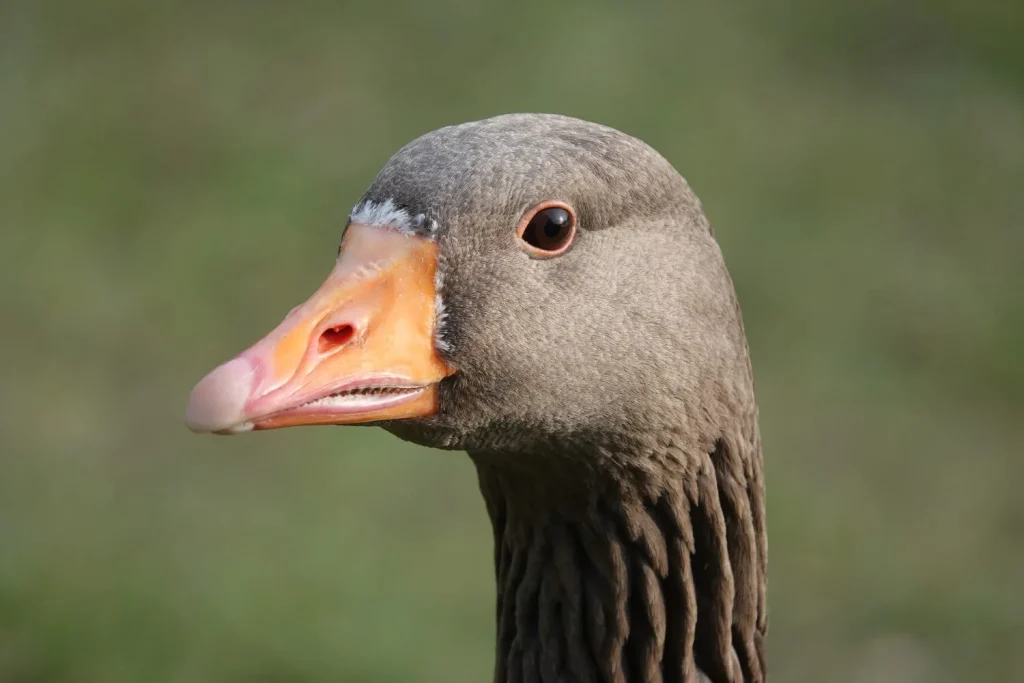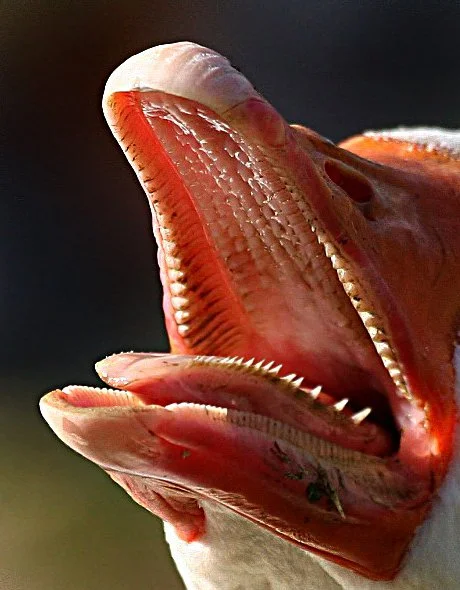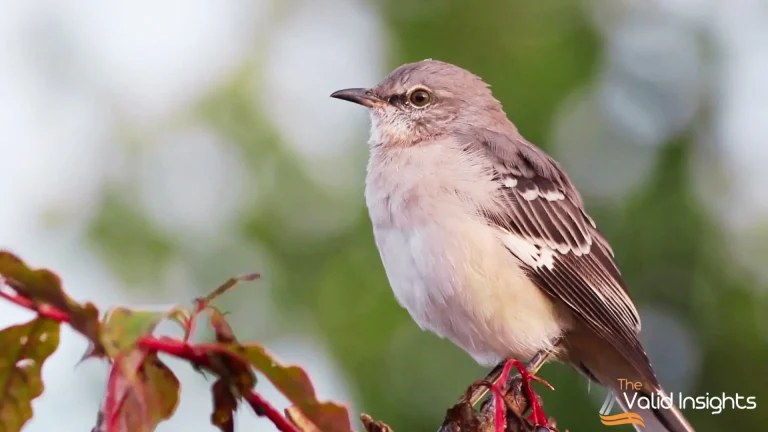Geese Teeth: Amazing Facts
What are Geese?
if you are a bird lover, you’ve probably seen geese around a lot, they’re those birds that can be found in city parks or out in the countryside. You may have been curious about geese teeth. People have mixed feelings about them. Some love watching them gracefully flying in the sky, while others get a bit uneasy thinking about running into a bold and assertive goose.

Are They Friendly?
Well, when it comes to friendliness, geese can be a bit unpredictable. Some folks find them charming to watch, especially when they’re flying together in those classic V-shaped formations. However, during nesting season, geese can get pretty protective and might not appreciate humans getting too close. So, it’s a bit of a mixed bag, admire them from a distance, and you’ll likely get along just fine.
Do Geese Have Teeth?
Now, let’s explore a peculiar notion: geese teeth. The idea of geese having teeth is a common misconception that often surprises those unfamiliar with the intricacies of avian anatomy.
Geese do not possess traditional teeth like mammals. However, they sport a fascinating adaptation known as “geese teeth” or Tomia. These are not true teeth made of enamel but rather cartilage-based serrations along the edges of their beaks.

Why Did Geese Develop Tomia?
The evolution of tomia likely stemmed from the changing diets of geese ancestors. Millions of years ago, geese were primarily insectivores. However, as competition for insects increased, some species turned to tougher plant materials for sustenance. This shift necessitated adaptations for efficient processing, leading to the development of tomia.
Key Feature of Geese Teeth:
- Tomia are keratinized structures, similar to our hair and nails, not true teeth made of enamel and dentine.
- They function as built-in graters, tearing and shredding vegetation for efficient digestion.
- Tomia vary in size and shape depending on the goose species’ diet, from robust grinders for grass to fine filters for aquatic plants.
- Beyond food processing, tomia serve other purposes like grooming, defense, and even nest building.
- Understanding tomia reveals the fascinating adaptations that allow geese to thrive in diverse environments.
Tomia’s Purpose:
These (geese teeth) tomia, often mistaken for teeth, play a crucial role in a goose’s life. They aid in cutting and processing tough vegetation, allowing geese to feed on roots, stems, grasses, and aquatic plants. Additionally, the serrated protrusions on their tongue assist in gripping small mammals and insects, showcasing the versatility of this adaptation.
- Serrated edges: The sharp, saw-like edges of the tomia tear and shred vegetation, making it easier for the goose to swallow and digest.
- Tongue teamwork: Tomia also line the edges of the goose’s tongue, acting like tiny rakes that pull food back into the beak for further processing.
- Strainers extraordinaire: Some geese boast tomia with backward-pointing hooks, acting as strainers that filter out unwanted grit and debris from their food.
Beyond Vegetation: Diverse Functions of Tomia
While primarily geared towards plant-based meals, tomia have other surprising uses:
- Grooming tools: Geese use their tomia to preen their feathers, keeping them clean and free of parasites.
- Defense mechanisms: While not meant for inflicting serious harm, a goose’s sharp tomia can deliver a painful nip if they feel threatened.
- Building materials: Some goose species even use their tomia to manipulate twigs and leaves when constructing their nests.

Diet of Geese:
The world of geese is diverse, and so are their diets. This variety is reflected in the structure and function of their tomia:
- Grazing specialists: Geese that primarily graze on grass and other tough vegetation have large, robust tomia for efficient shredding.
- Aquatic adepts: Geese that feed on aquatic plants often have smaller, finer tomia better suited for filtering and manipulating their watery meals.
- Fishy feasts: A few goose species, like the merganser, have tomia with backward-pointing spines on their bills, ideal for catching and holding slippery fish.
See Also: Lipstick plant’s Amazing Facts
Geese As Pets:
Geese can indeed be kept as pets, offering an interesting and rewarding experience for some owners. However, it’s important to understand the commitment and challenges involved before welcoming geese into your life.
Here are some key considerations before choosing geese as pets:
Space and Outdoor Access: Geese need significant space to roam and graze. A large, secure yard with access to water (pond, pool, or large waterer) is essential. They also require sturdy fencing to prevent escape and deter predators.
Legal and Zoning Restrictions: Make sure owning geese is legal in your area and check any local zoning regulations regarding poultry.
Time and Responsibility: Geese are social creatures and require daily interaction and care. This includes cleaning their enclosure, providing fresh food and water, monitoring their health, and offering enrichment activities.
Noise and Mess: Geese are vocal animals and their honking can be loud, especially when territorial or excited. Additionally, they defecate frequently, and cleaning their enclosure can be a messy task.
Potential Conflicts: Geese can be territorial and aggressive, especially during breeding season. They may attack other animals or even people they perceive as threats. Proper socialization and training are crucial to minimize these risks.
Diet and Nutrition: Geese are primarily herbivores and their diet should consist mainly of grass, leafy greens, vegetables, and fruits. Commercial waterfowl pellets can supplement their natural food sources. Avoid processed foods and limit treats.
Veterinary Care: Like any pet, geese require regular veterinary checkups and vaccinations. Find a veterinarian familiar with avian species who can provide proper care.
Lifespan: Geese can live for 15-20 years, so adopting them is a long-term commitment.
Alternative Options: If you’re interested in waterfowl but live in a smaller space or have concerns about the commitment, consider smaller species like ducks, which require less space and may be more adaptable to a suburban environment.
Assuming you’ve carefully considered these factors and are confident you can provide a suitable environment and care for geese, here’s a basic guide to their diet:
Primary Food:
- Grass and leafy greens: This should be the foundation of their diet, offering essential fiber and nutrients.
- Vegetables: Provide a variety of vegetables like lettuce, kale, carrots, and broccoli.
- Fruits: Offer fruits like apples, berries, and melons as occasional treats.
Supplements:
- Commercial waterfowl pellets: These pellets provide balanced nutrition and can be especially helpful during winter months when fresh greens are scarce.
- Grit: Geese swallow small stones and pebbles to aid digestion. Provide grit specifically formulated for poultry.
Important Points:
- Avoid foods high in sugar, fat, and salt, as these can be harmful to geese.
- Ensure access to clean, fresh water at all times.
- Monitor your geese’s feed intake and adjust as needed to maintain a healthy weight.
- Consult a veterinarian for specific dietary recommendations based on your geese’s age, breed, and any health conditions.
Conclusion:
In the cool world of geese, where they fly around all graceful and honk so loudly, there’s a super interesting story. Turns out, geese don’t really have teeth like us, but they have these special thingies called tomia known as geese teeth. These tomia help them eat tough stuff and protect themselves. Whether they’re making a ruckus during nesting season or using their tomia for munching and staying safe, geese are like the superheroes of the wild. Flying high or chilling as pets, geese have this awesome story that’s not just about honks but about being tough and smart in nature. It’s like nature’s way of saying, “Hey, check out these cool tales woven into our world!”
Click Here to read about the Northern Mockingbirds





